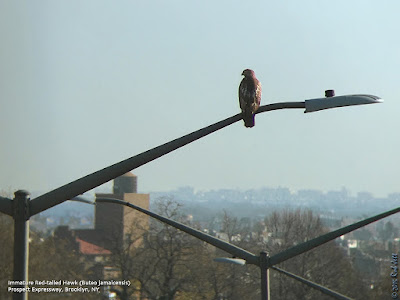Below is the New York City Rare Bird Alert for the week ending Friday, December 25, 2015:
-RBA
* New York
* New York City, Long Island, Westchester County
* Dec. 25, 2015
* NYNY1512.25
- Birds Mentioned
SWAINSON’S HAWK+
ASH-THROATED FLYCATCHER+
PAINTED BUNTING+
(+ Details requested by NYSARC)
Greater White-Fronted Goose
ROSS’S GOOSE
Cackling Goose
Tundra Swan
Eurasian Wigeon
Blue-winged Teal
TUFTED DUCK
KING EIDER
Red-necked Grebe
NORTHERN FULMAR
Sooty Shearwater
Northern Gannet
AMERICAN WHITE PELICAN
American Bittern
Great Egret
Green Heron
Turkey Vulture
Bald Eagle
Virginia Rail
Sora
Long-billed Dowitcher
DOVEKIE
Razorbill
Black-legged Kittiwake
BLACK-HEADED GULL
Laughing Gull
Iceland Gull
Lesser Black-backed Gull
Snowy Owl
Long-eared Owl
Short-eared Owl
Blue-headed Vireo
Common Raven
CAVE SWALLOW
TOWNSEND’S SOLITAIRE
Lapland Longspur
Worm-eating Warbler
Black-and-white Warbler
Orange-crowned Warbler
Nashville Warbler
Yellow Warbler
Pine Warbler
Prairie Warbler
Wilson’s Warbler
CLAY-COLORED SPARROW
LARK SPARROW
Lincoln’s Sparrow
Baltimore Oriole
Common Redpoll
If followed by (+) please submit documentation of your report electronically and use the NYSARC online submission form found at http://www.nybirds.org/NYSARC/goodreport.htm
You can also send reports and digital image files via email to nysarc44nybirdsorg
If electronic submission is not possible, hardcopy reports and photos or sketches are welcome. Hardcopy documentation should be mailed to:
Gary Chapin - Secretary
NYS Avian Records Committee (NYSARC)
125 Pine Springs Drive
Ticonderoga, NY 12883
Hotline: New York City Area Rare Bird Alert
Number: (212) 979-3070
Compiler: Tom Burke, Tony Lauro
Coverage: New York City, Long Island, Westchester County
Transcriber: Gail Benson
[~BEGIN RBA TAPE~]
Greetings! This is the New York Rare Bird Alert for Thursday, December 25, 2015 at 9:00 pm.
The highlights of today’s tape are Christmas Count results, including PAINTED BUNTING, SWAINSON’S HAWK, ASH-THROATED FLYCATCHER, DOVEKIE, NORTHERN FULMAR, AMERICAN WHITE PELICAN, TUFTED DUCK, KING EIDER, BLACK-HEADED GULL, TOWNSEND’S SOLITAIRE and LARK and CLAY-COLORED SPARROWS, plus CAVE SWALLOW and ROSS’S GOOSE.
Last Saturday’s start to the Christmas Count season began with mild temperatures, which enabled several rare stake-outs to stick around, but also strong winds, which did have a negative impact on most counts.
The Queens Count came in with the highest total Saturday, 119 species, their highlights including CACKLING GOOSE at Flushing Meadows, EURASIAN WIGEON and 3 BLUE-WINGED TEAL on the East Pond at Jamaica Bay Wildlife Refuge, where the 2 AMERICAN WHITE PELICANS also returned for the Count, 3 BALD EAGLES, SNOWY OWL at JFK Airport, COMMON RAVEN, 3 PINE and 2 NASHVILLE WARBLERS, plus a Count Period WORM-EATING WARBLER the day before at Forest Park and the now well publicized CLAY-COLORED and LARK SPARROWS, still present today at Flushing Meadows Park near the Meditation Garden north of the Long Island Expressway.
The Kings (Brooklyn) Count Saturday recorded 117 species including AMERICAN BITTERN, BALD EAGLE, the immature BLACK-HEADED GULL on Prospect Park Lake, a BLUE-HEADED VIREO, new for the count, 1 YELLOW, 1 NASHVILLE, and 3 ORANGE-CROWNED WARBLERS, and the now famous PAINTED BUNTING at Prospect Park, still present yesterday around the green roof at the LeFrak Center in the southeast corner of the park.
The Montauk Count Saturday, killed by winds cancelling any coverage of Gardiner’s Island, netted just 111 species, including a drake KING EIDER off the south side of the Point, GREEN HERON, 3 VIRGINIA RAILS, 1 ICELAND, 1 LESSER BLACK-BACKED and 2 LAUGHING GULLS, 3 DOVEKIES and a good number of RAZORBILLS, SNOWY and SHORT-EARED OWLS, an ASH-THROATED FLYCATCHER and a COMMON REDPOLL. The morning before off Amagansett, 4 NORTHERN FULMARS, a SOOTY SHEARWATER and a BLACK-LEGGED KITTIWAKE were seen during a sea watch. The ASH-THROATED FLYCATCHER was still present today at the Fort Hill Cemetery in Montauk; look along the bush line on the northern side of the Cemetery located just west of the Montauk Manor, approached from Essex Street.
The Northern Nassau Count Saturday counted 102 species, including NORTHERN GANNET, 5 LAUGHING GULLS, TURKEY VULTURES, RED-NECKED GREBE, BALTIMORE ORIOLE, ORANGE-CROWNED WARBLER, and 2 new count additions, a LAPLAND LONGSPUR and a female PAINTED BUNTING - the BUNTING was at Caumsett State Park well away from the parking lot and could not later be relocated.
Rarities on 2 Saturday counts with unknown results included the SWAINSON’S HAWK at the Great Kills Landfill on Staten Island and the LARK SPARROW at Croton Point Park in the Peekskill Count circle. The SWAINSON’S HAWK was still being seen yesterday, but the issue here is visibility of the closed landfill, with the periphery off Richmond Avenue sometimes productive.
Under better conditions Sunday, the Captree Count recorded 122 species – 2 new additions were the immature TUFTED DUCK on Capri Lake in West Islip and 10 LONG-BILLED DOWITCHERS at Santapogue Creek in Lindenhurst, the TUFTED still present Thursday. Capri Lake is on the north side of Route 27A, 7/10ths of a mile west of the Robert Moses Causeway. Also counted were PRAIRIE, NASHVILLE, and 3 ORANGE-CROWNED WARBLERS, and LINCOLN’S SPARROW.
The Greenwich-Stamford Count Sunday, including parts of Westchester County, netted 101 species including 2 CACKLING GEESE, GREAT EGRET, RED-NECKED GREBE, LONG-EARED OWL, BALTIMORE ORIOLE, and the TOWNSEND’S SOLITAIRE still lingering in Cos Cob, CT.
The Rockland County Count Sunday netted 78 species, including 16 COMMON RAVENS, and in Central Park as part of the Lower Hudson Count Sunday they found ORANGE-CROWNED, WILSON’S and BLACK-AND-WHITE WARBLERS.
A ROSS’S GOOSE continues to visit Eastport Lake off Montauk Highway, and recently there have been 2 TUNDRA SWANS and 2 GREATER WHITE-FRONTED GEESE on Hook Pond in East Hampton. A CAVE SWALLOW was on Fire Island on the 18th.
Happy holidays! To phone in reports, on Long Island call Tony Lauro at (631) 734-4126, or weekdays call Tom Burke at (212) 372-1483.
This service is sponsored by the Linnaean Society of New York and the National Audubon Society. Thank you for calling.
- End transcript
...Read more


















